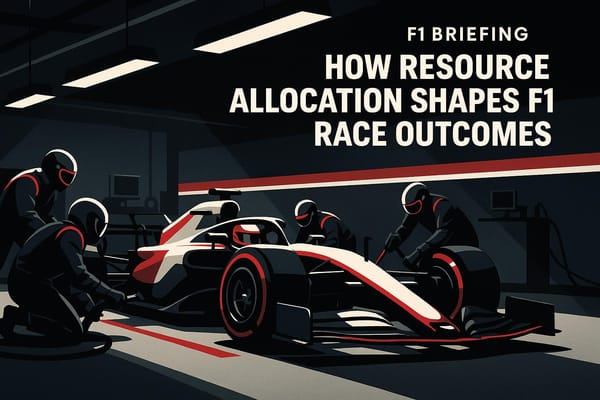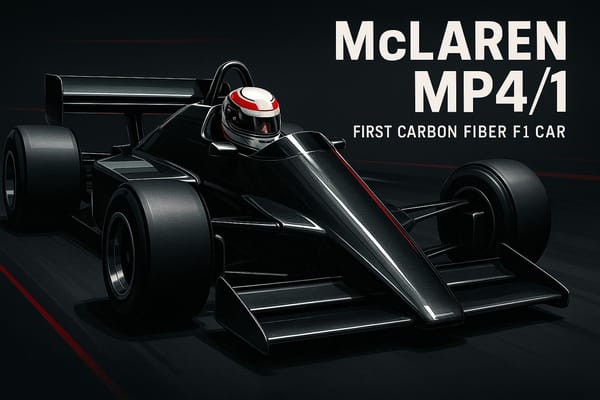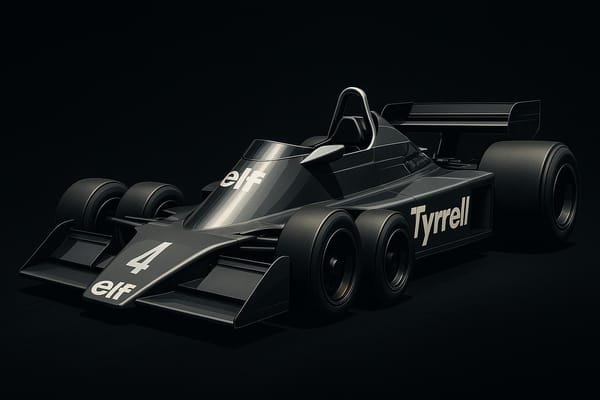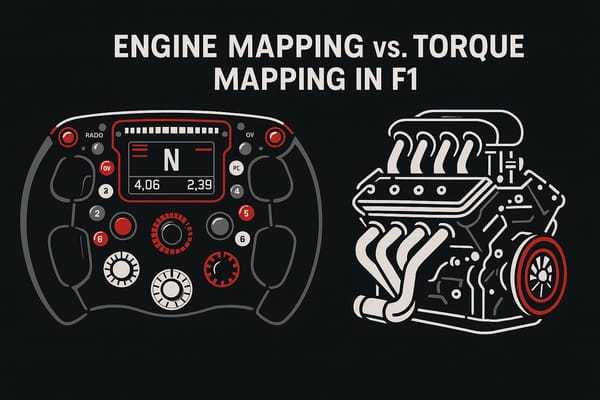Safety Car vs. Red Flag: Impact on Race Strategy
Explore how Safety Cars and Red Flags dramatically alter race strategies in Formula 1, impacting everything from pit stops to tire management.
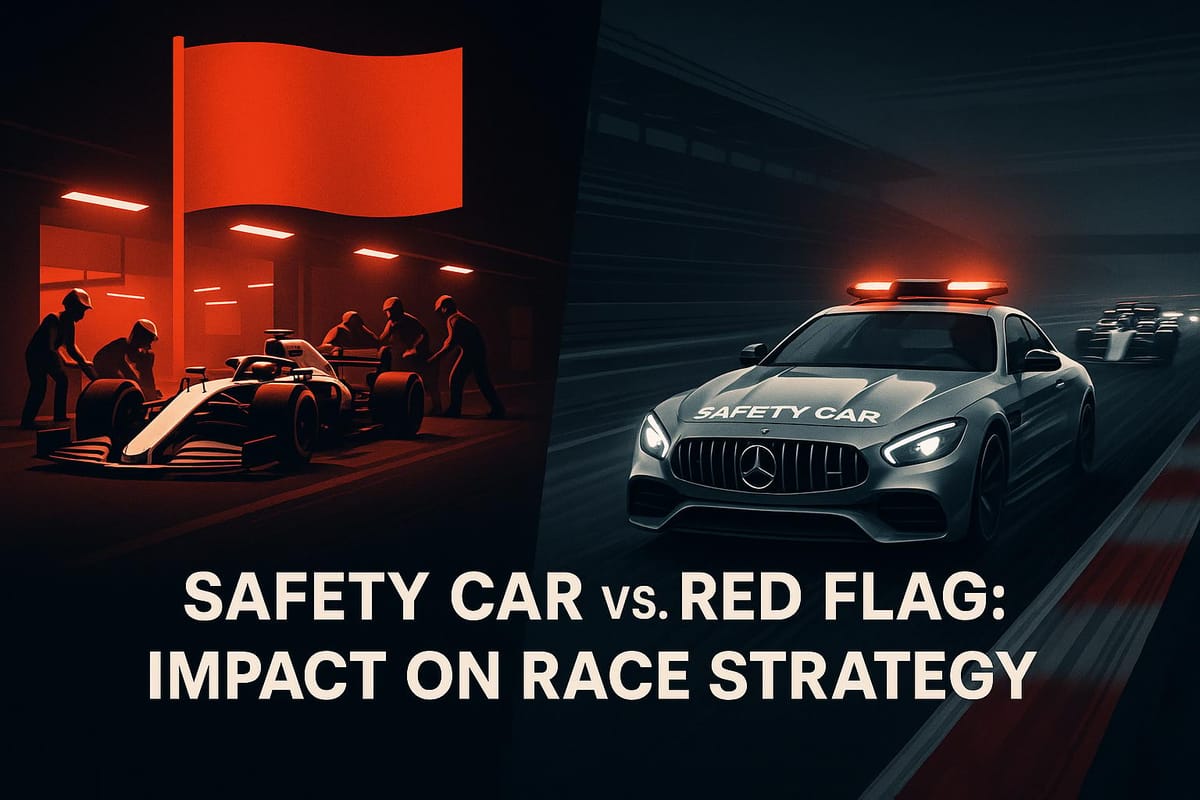
Safety Cars and Red Flags can change a Formula 1 race in seconds. Both are safety measures but have very different effects on race strategy. Here's a quick breakdown:
- Safety Car: Slows the race but keeps it moving. Drivers stay on track at reduced speed, creating opportunities for "cheap" pit stops and bunching up the field, erasing time gaps.
- Red Flag: Stops the race entirely. Cars return to the pit lane, allowing free tire changes and repairs, resetting strategies and often reshuffling positions.
Quick Comparison
| Aspect | Safety Car | Red Flag |
|---|---|---|
| Race Flow | Slows but continues | Completely halts |
| Pit Stop Cost | Reduced by ~6 seconds | Free (no time loss) |
| Repairs | Limited during pit stops | Full repairs allowed |
| Restart Type | Rolling restart | Standing or rolling restart |
| Field Impact | Bunches up field, erasing gaps | Resets positions and strategies |
Both measures demand quick thinking and adaptability from teams. Whether it's a Safety Car or a Red Flag, timing and decisions can make or break a race.
How do you get a 'free pit stop' under the Safety Car in F1?
How Safety Car Affects Race Strategy
The Safety Car shakes up race strategies, forcing teams to adapt quickly to protect their position or seize new opportunities. Its deployment can dramatically influence the race outcome, introducing both risks and rewards.
When and Why the Safety Car is Deployed
The Safety Car is typically brought out for incidents like minor crashes, debris on the track, stalled cars, or other situations requiring heightened caution. Interestingly, the likelihood of a Safety Car varies by circuit. For instance, Singapore has a 100% chance of deployment based on historical data, while tracks like Hungary and Bahrain are far less likely to see one.
When the Safety Car is on track, lap times drop by about 20% due to the reduced speed limit. This slower pace creates a tactical window for teams to capitalize on pit stops, minimizing the usual time penalty.
Pit Stop Opportunities and Tire Decisions
Safety Car periods are prime moments for "cheap" pit stops. Normally, a pit stop costs 20 to 30 seconds, depending on the circuit. Under Safety Car conditions, the time loss is significantly reduced.
"You're saving time because the speed of the cars that remain on track while you're taking your stop is comparatively slower, so you're not losing as much ground for the same stop." – Jason McDonald
However, deciding whether to pit is anything but simple. Teams must consider factors like track position, tire wear, fuel levels, and the possibility of another Safety Car later in the race. The strategy team works overtime, running scenarios to predict the best course of action. As Mercedes-AMG PETRONAS F1 Team puts it:
"The biggest challenge a Safety Car brings to the team is making the right strategy choices."
One major complication is tire temperature. Under the Safety Car, tire temperatures can drop by around 40°C, reducing grip and making the choice between fresh tires and maintaining track position even tougher. Once pit stops are completed, the compressed field adds another layer of complexity during the restart.
Field Bunching and Position Changes
When the Safety Car is out, the entire field bunches up, erasing the gaps drivers have worked hard to create. A driver with a 20-second lead can suddenly find themselves right on the tail of their competitors, which can be both an opportunity and a challenge.
For backmarkers, this is a chance to close gaps and prepare for overtakes. But the restart itself is no walk in the park. Drivers face a tricky situation as their tires, having cooled significantly, offer less grip.
"For the drivers, the restart of the race is especially challenging. This moment is tricky because the tyres don't just lose temperature under the Safety Car, but also grip." – Mercedes-AMG PETRONAS F1 Team
Beyond individual races, the impact of Safety Cars can shape entire seasons. Last year, Safety Car deployments increased by 40% compared to the previous record, and in 2010, a full 8% of the season's laps were completed behind the Safety Car. These periods also allow teams to save fuel, giving them added flexibility for the remainder of the race.
How Red Flag Affects Race Strategy
Red flags bring a race to a complete halt, presenting teams with both rare opportunities and unique challenges to navigate.
What Causes a Red Flag
Red flags are issued in situations where continuing the race would be too dangerous. This could include major accidents leaving debris scattered across the track, significant damage to barriers requiring extensive repairs, or severe weather conditions. The decision hinges on time and safety: if repairs are expected to take 30 minutes or more, race officials typically choose a red flag over extending a Safety Car period. Race directors must assess whether the track can be safely managed under a Safety Car or if halting the race entirely is the safer option. This pause gives teams a chance to regroup, often leading to strategic shifts.
Tire Changes and Car Repairs During Red Flag
One of the most debated aspects of a red flag is the "free pit stop." Teams can change tires and make repairs without losing track position. They can also tweak front wing settings and adjust cockpit setups for driver comfort, all while keeping their restart position intact.
This rule has sparked strong opinions among drivers. Lando Norris expressed his dissatisfaction, stating:
"It's possibly the worst rule ever invented by someone. Every driver has disagreed with it in the past"
On the other hand, race strategist Bernie Collins offered a different perspective:
"The rule has always been the subject of debate but I think there are pretty good reasons why it's the way it is, and it's also universal for everyone"
Temperature management plays a critical role during red flag periods. Unlike Safety Car intervals, where tire temperatures can drop significantly, red flags allow teams to install fresh, pre-heated tires, ensuring optimal performance for the restart.
Race Restarts and Position Shuffles
The "free pit stops" during a red flag often lead to position reshuffles and a reset of race dynamics. In dry conditions, the FIA usually opts for a standing start, creating an intense restart scenario.
A prime example of red flag strategy unfolded during the 2021 Silverstone Grand Prix. After Lewis Hamilton collided with Max Verstappen on the first lap, Mercedes used the red flag period to repair Hamilton's car. This allowed him to restart the race and ultimately claim victory.
Racing analyst Victoria Ursino highlights the controversies surrounding red flags:
"The application of Red Flags often sparks heated debates, from the inconsistent handling of qualifying disruptions to the strategic chaos caused by free pit stops during races"
For teams, red flags are now a key consideration in race strategy. While they can erase an early lead, they also offer a lifeline to those who have fallen behind. This creates a constant balancing act in Formula 1: teams must weigh the risks of aggressive early moves against the possibility of a red flag reshaping the race.
Safety Car vs Red Flag: Direct Comparison
Both the Safety Car and Red Flag serve as essential tools to ensure safety in Formula 1, but they impact race strategies in very different ways. These interventions can completely alter the course of a race, forcing teams to adjust their tactics on the fly.
Main Differences in Race Impact
The strategic effects of a Safety Car versus a Red Flag vary significantly across several aspects:
| Aspect | Safety Car | Red Flag |
|---|---|---|
| Pit Stop Cost | Saves about 6 seconds compared to a regular pit stop | Completely free - teams can change tires and make repairs without any time penalty |
| Race Flow | Slows the race down, with the field bunched up behind the Safety Car | Brings the race to a complete stop, halting all progress |
| Repair Opportunities | Limited to what can be done during a quick pit stop | Allows full car repairs and setup adjustments |
| Restart Type | Rolling restart that keeps the current order mostly intact | Often a standing start, which can lead to major position changes |
| Strategic Reset | Compresses time gaps but keeps relative positions the same | Completely resets strategies, erasing earlier advantages |
These differences create distinct challenges and opportunities for teams during the race. For example, during the 2024 São Paulo Grand Prix, a red flag caused by Franco Colapinto’s crash on lap 32 gave a huge advantage to drivers like Esteban Ocon, Max Verstappen, and Pierre Gasly, who hadn’t yet switched to wet tires. They were able to change tires during the stoppage without losing time, while early leaders George Russell and Lando Norris - who had already pitted under a virtual safety car - saw their strategies unravel.
Benefits and Drawbacks for Teams
Each intervention comes with its own set of pros and cons that can drastically affect team strategies. For instance, a Safety Car deployment often benefits teams trying to recover from behind, as it reduces the time lost during pit stops and compresses the field. On the flip side, race leaders risk losing their hard-earned gaps as the pack bunches up.
Red Flags, however, provide a more dramatic reset. Teams can change tires, repair damage, and even adjust setups without the usual time penalties. This can be a lifeline for teams that fell behind earlier in the race but can also erase the advantages of those who executed flawless strategies up to that point.
Timing is everything. An early Safety Car can help struggling teams close gaps, while a late deployment might hand an unexpected advantage to drivers further down the order. Red Flags amplify these effects even more. Take the 2011 Monaco Grand Prix, for example: Sebastian Vettel, leading on worn tires, was saved by a late red flag that allowed him and his competitors to switch to fresh tires, completely shifting the race’s outcome.
Teams must be prepared for both scenarios and factor them into their race strategies. As Miles Goldsack explains:
A full stop (red flag) is obviously safer but is a bigger interruption to proceedings and has more strategic implications like free pitstops
The numbers back up the importance of these interventions. As of October 2024, 87 Grand Prix races have featured red flag events, with 26 of those occurring on the very first lap. The 2023 Australian Grand Prix even set a record with three red flags in a single race, showcasing how these stoppages can completely rewrite the competitive script.
Team Responses and Decision Making
When Safety Cars or Red Flags disrupt a race, teams are thrust into a high-stakes environment where quick thinking and precise decision-making are essential. These interruptions demand teams to process vast amounts of data, communicate effectively, and adjust strategies on the fly. In Formula 1, the ability to adapt in these moments often determines who crosses the finish line first.
Live Data Analysis and Team Communication
Modern Formula 1 teams depend heavily on real-time data to make split-second decisions during race interruptions. Each car is equipped with 250 sensors that collect 10,000 data points every second, tracking everything from tire temperatures to fuel consumption. Over the course of a race weekend, a single car generates more than 1 terabyte of data.
This constant flow of information becomes critical when a Safety Car or Red Flag is deployed. Teams analyze live telemetry - received within just 10 milliseconds at European races - to evaluate tire conditions, fuel levels, and weather changes, determining the best course of action.
"Real-time data is vital in F1 racing as it gives drivers insights into the performance of their vehicles, allowing them to make split-second decisions that can provide them with an edge over the competition." – Rupesh N. Bhambwani
Advancements in technology have significantly reduced decision-making times. Formula 1's latest tech upgrades now allow teams to process live data, video feeds, and AI analysis, enabling them to make strategic choices in under five seconds. This speed is crucial, especially during interruptions where every second counts.
Communication strategies also shift depending on the type of race interruption. During a Safety Car deployment, teams focus on immediate decisions like pit stops and tire management, maintaining constant radio communication with drivers about track conditions and positioning. Although the race continues at a controlled pace, the pressure remains intense.
Red Flag situations, however, require a more comprehensive approach. These stoppages give teams time to reassess their entire strategy, involving input from strategists, engineers, and mechanics. Discussions often revolve around tire changes, potential repairs, and preparations for the restart. The unpredictable nature of Red Flags demands a more flexible and collaborative communication process.
Some teams are now leveraging predictive analytics to stay ahead. For example, in 2022, United Autosports used Valkyrie AI to analyze timing and scoring patterns, helping predict when Safety Cars or yellow flags were likely. This foresight offers a competitive edge when interruptions occur.
"The Team Content Delivery System will further evolve the ways teams consume and process key trackside data to support them in making faster and more informed decisions when they need it most." – Chris Roberts, director of IT at Formula 1
While live data and advanced tools empower teams to navigate race interruptions effectively, the decisions made by Race Control add another layer of complexity.
Race Control Decisions and Their Effects
Race Control's choices regarding Safety Cars or Red Flags can completely reshape the dynamics of a race. These interventions force teams to abandon carefully crafted strategies and adapt to new conditions in real time.
When Race Control deploys a Safety Car instead of a Red Flag, teams face unique challenges. A pit stop under a Safety Car saves approximately six seconds compared to a regular stop, but this advantage comes with risks, such as losing track position. Teams with drivers on older tires often benefit, while those who recently pitted may see their hard-earned lead disappear as the field bunches up.
Red Flag decisions, on the other hand, lead to even more dramatic shifts. Under current rules, teams can fit fresh tires during a Red Flag stoppage, effectively erasing earlier tire strategies. This creates opportunities for drivers who haven’t pitted yet, while forcing teams to decide whether to change compounds, make repairs, or adjust setups during the pause.
Restart scenarios also play a critical role. Whether Race Control opts for a standing or rolling restart significantly impacts tire warming and driver positioning, requiring teams to fine-tune their tactics once again. These interruptions disrupt momentum and demand swift, calculated pivots to stay competitive.
AI and machine learning are increasingly helping teams anticipate and react to Race Control decisions. However, as McLaren's Edward Green emphasizes, technology is a tool, not a replacement for human expertise:
"AI is not there to replace anybody. AI is there to add to our data scientists and engineers and helps inform their decisions." – Edward Green
The teams that thrive in these high-pressure moments are those that seamlessly blend cutting-edge technology with the intuition and experience of their strategists, engineers, and drivers. The ability to adapt strategies within seconds of a Safety Car or Red Flag deployment often defines the difference between championship contenders and the rest of the grid.
Conclusion: Key Lessons from Safety Car and Red Flag Impact
The contrasting effects of Safety Car deployments and Red Flag situations play a crucial role in shaping Formula 1 race strategies. Safety Cars bunch up the field, creating opportunities for pit stops, while Red Flags bring the race to a full stop, allowing teams to change tires and make repairs without losing track position.
One major takeaway from these scenarios is that flexibility often outweighs meticulous pre-race preparation. High-profile races have shown how Red Flags can completely overturn strategic advantages, proving that teams must stay nimble and ready to adapt, no matter how well-laid their plans may be.
Timing is everything when it comes to these interventions. Red Flags can dramatically shift the course of a race by neutralizing any lead a team has built, while Safety Cars maintain the flow of the race and offer more predictable chances for pit stops. A prime example is the 2021 Baku Grand Prix, where a late Red Flag led to a one-lap shootout that cost Lewis Hamilton crucial points.
The unpredictable nature of these interruptions highlights the importance of quick, informed decision-making. Teams must be ready to pivot their strategies instantly, weighing the risks and rewards of sticking to suboptimal tire strategies - a gamble that paid off during the São Paulo 2024 race.
Fernando Alonso captured the essence of this unpredictability when he said:
"I was surprised with all the red flags, to be honest... But we never know in the car what's going on - on the track itself. So apparently, maybe one barrier was not properly fit there, so I think the FIA has more information than us. So if there is a red flag, it has to be for a reason."
FAQs
What factors influence a team's decision to pit during a Safety Car period?
During a Safety Car period in Formula 1, teams face a critical decision: take advantage of the shorter pit stop time or stay out and avoid potential complications. With the race pace reduced, pitting can shave off valuable seconds and even lead to gaining positions on track. But it’s not always a simple call.
Key considerations include the condition of the tires - worn or cold tires could struggle to perform when the race gets back up to speed. Teams also need to assess how a pit stop fits into their broader strategy, factoring in fuel levels and maintaining an optimal track position. Ultimately, the decision comes down to analyzing real-time data, understanding the race dynamics, and being ready to adjust as conditions change.
How does a Red Flag impact tire strategy and car repairs during a Formula 1 race?
The Impact of a Red Flag on Formula 1 Strategy
In Formula 1, a Red Flag can completely shift the dynamics of a race. When the action is halted, teams are allowed to change tires and make car repairs without losing their position on the track. Essentially, it’s like getting a "free pit stop", which can be a massive advantage. Teams can adjust their tire strategy to match changing track conditions or fix any damage without the usual time cost.
That said, this rule often sparks debate. It can unexpectedly favor drivers who haven’t pitted yet, giving them a leg up and potentially disrupting the competitive balance. While Red Flags open the door to strategic opportunities, they also stir up questions about fairness and how they might influence the final results.
How do Safety Cars and Red Flags influence race strategy and outcomes in Formula 1?
Safety Cars and Red Flags are game-changers in Formula 1, often shaking up race strategies and outcomes. When a Safety Car is deployed, it slows the pace of the entire field, giving drivers a chance to pit with far less time loss compared to normal racing conditions. For teams, this presents a golden opportunity to make strategic pit stops that could shift the race in their favor.
Red Flags, on the other hand, bring the race to a complete stop. This pause allows teams to make tire changes or repair damage without sacrificing track position. Such moments can completely reshape the grid order and alter the race's rhythm. The timing of these interruptions forces teams to make lightning-fast decisions, weighing risks against potential rewards - decisions that can ultimately decide who comes out on top.

